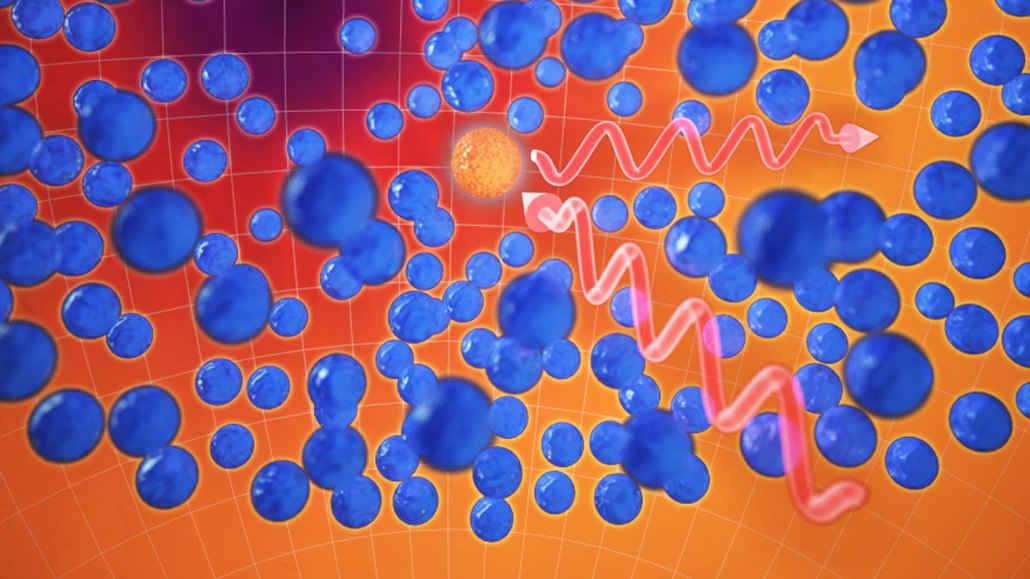Scientists finally detected a quantum effect that blocks atoms from scattering light
When all available quantum states are full, ultracold atom clouds become more transparent

In an ultracold, dense cloud of atoms (blue), a quantum effect dictates whether atoms scatter light (red arrows). If the quantum states are fully occupied, the atoms cannot change quantum states and the light isn’t scattered.
Illustration by Steven Burrows/JILA
- More than 2 years ago
A cloud of ultracold atoms is like a motel with a neon “no vacancy” sign.
If a guest at the motel wants to switch rooms, they’re out of luck. No vacant rooms means there’s no choice but to stay put. Likewise, in new experiments, atoms boxed in by crowded conditions have no way to switch up their quantum states. That constraint means the atoms don’t scatter light as they normally would, three teams of researchers report in the Nov. 19 Science. Predicted more than three decades ago, this effect has now been seen for the first time.
Under normal circumstances, atoms interact readily with light. Shine a beam of light on a cloud of atoms, and they’ll scatter some of that light in all directions. This type of light scattering is a common phenomenon: It happens in Earth’s atmosphere. “We see the sky as blue because of scattered radiation from the sun,” says Yair Margalit, who was part of the team at MIT that performed one of the experiments.
But quantum physics comes to the fore in ultracold, dense atom clouds. “The way they interact with light or scatter light is different,” says physicist Amita Deb of the University of Otago in Dunedin, New Zealand, a coauthor of another of the studies.
According to a rule called the Pauli exclusion principle, atoms in the experiments can’t take on the same quantum state — namely, they can’t have the same momentum as another atom in the experiment (SN: 5/19/20). If atoms are packed together in a dense cloud and cooled to near absolute zero, they’ll settle into the lowest-energy quantum states. Those low-energy states will be entirely filled, like a motel with no open rooms.
When an atom scatters light, it gets a kick of momentum, changing its quantum state, as it sends light off in another direction. But if the atom can’t change its state due to the crowded conditions, it won’t scatter the light. The atom cloud becomes more transparent, letting light through instead of scattering it.
To observe the effect, Margalit and colleagues beamed light through a cloud of lithium atoms, measuring the amount of light it scattered. Then, the team decreased the temperature to make the atoms fill up the lowest energy states, suppressing the scattering of light. As the temperature dropped, the atoms scattered 37 percent less light, indicating that many atoms were prevented from scattering light. (Some atoms can still scatter light, for example if they get kicked into higher-energy quantum states that are unoccupied.)
In another experiment, physicist Christian Sanner of the research institute JILA in Boulder, Colo., and colleagues studied a cloud of ultracold strontium atoms. The researchers measured how much light was scattered at small angles, for which the atoms are jostled less by the light and therefore are even less likely to be able to find an unoccupied quantum state. At lower temperatures, the atoms scattered half as much light as at higher temperatures.
The third experiment, performed by Deb and physicist Niels Kjærgaard, also of the University of Otago, measured a similar scattering drop in an ultracold potassium atom cloud and a corresponding increase in how much light was transmitted through the cloud.
Because the Pauli exclusion principle also governs how electrons, protons and neutrons behave, it is responsible for the structure of atoms and matter as we know it. These new results reveal the wide-ranging principle in a new context, says Sanner. “It’s fascinating because it shows a very fundamental principle in nature at work.”
The work also suggests new ways to control light and atoms. “One could imagine a lot of interesting applications,” says theoretical physicist Peter Zoller of the University of Innsbruck in Austria, who was not involved with the research. In particular, light scattering is closely related to a process called spontaneous emission, in which an atom in a high-energy state decays to a lower energy by emitting light. The results suggest that decay could be blocked, increasing the lifetime of the energetic state. Such a technique might be useful for storing quantum information for a lengthier period of time than is normally possible, for example in a quantum computer.
So far, these applications are still theoretical, Zoller says. “How realistic they are is something to be explored in the future.”







